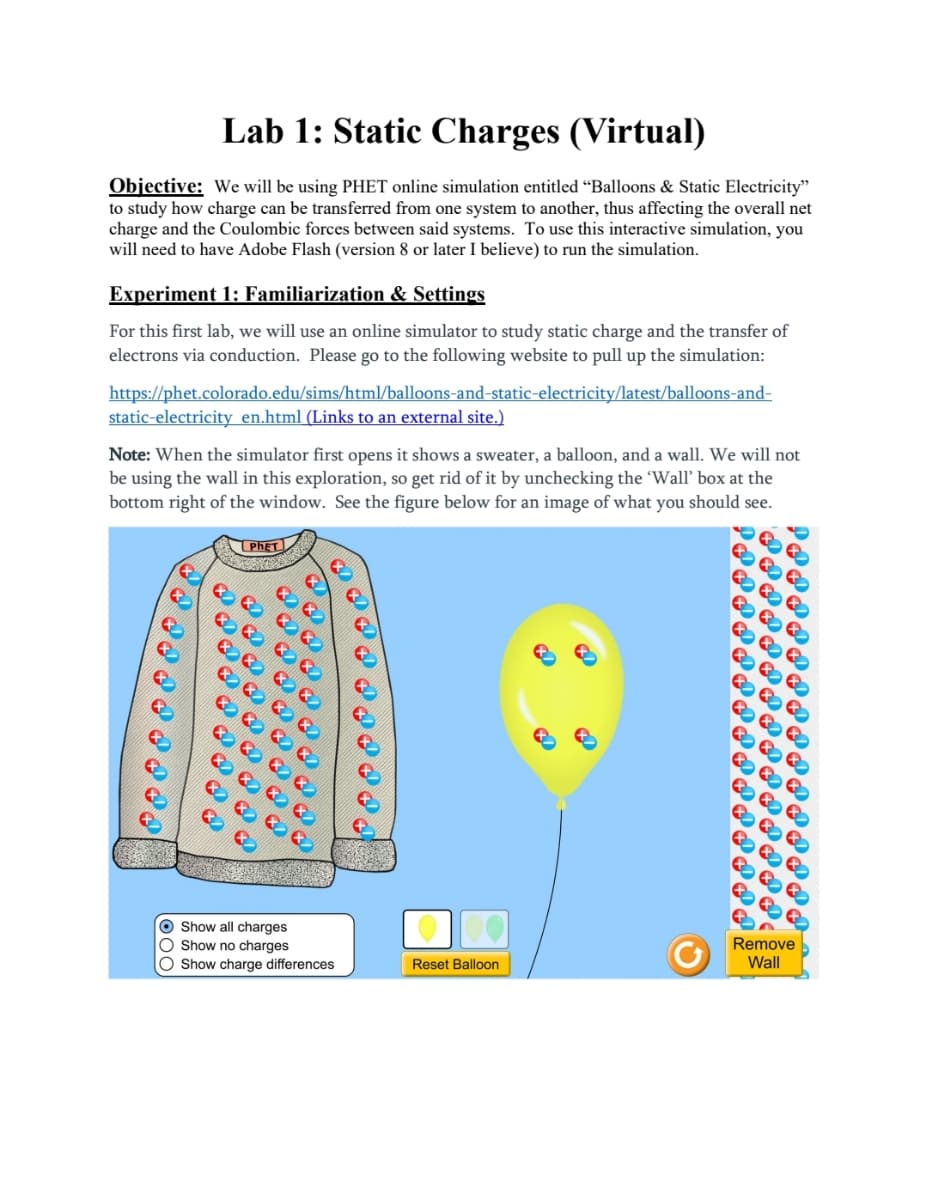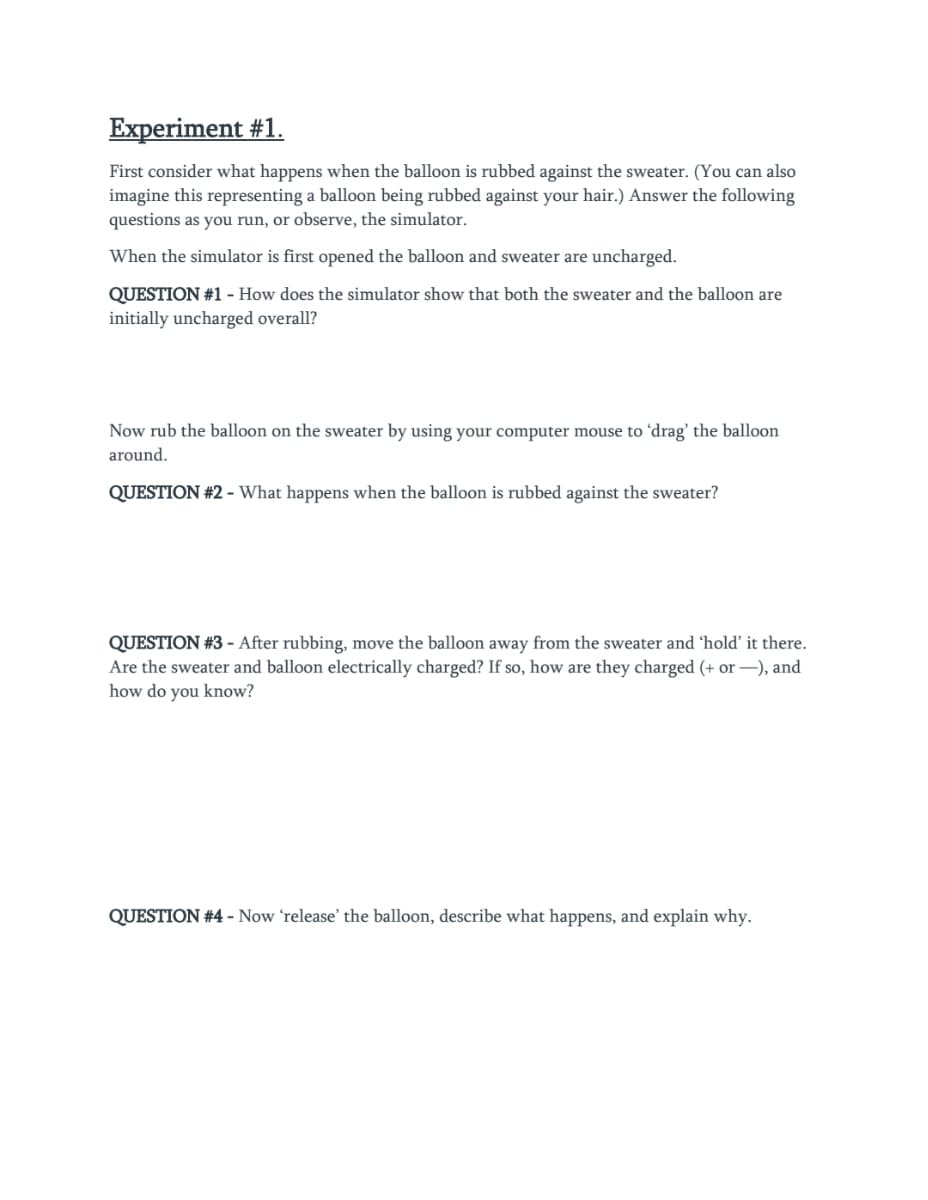QUESTION #2 - What happens when the balloon is rubbed against the sweater? QUESTION #3 - After rubbing, move the balloon away from the sweater and 'hold’ it there. Are the sweater and balloon electrically charged? If so, how are they charged (+ or -), and how do you know? QUESTION #4 - Now 'release' the balloon, describe what happens, and explain why.
QUESTION #2 - What happens when the balloon is rubbed against the sweater? QUESTION #3 - After rubbing, move the balloon away from the sweater and 'hold’ it there. Are the sweater and balloon electrically charged? If so, how are they charged (+ or -), and how do you know? QUESTION #4 - Now 'release' the balloon, describe what happens, and explain why.
Principles of Physics: A Calculus-Based Text
5th Edition
ISBN:9781133104261
Author:Raymond A. Serway, John W. Jewett
Publisher:Raymond A. Serway, John W. Jewett
Chapter19: Electric Forces And Electric Fields
Section: Chapter Questions
Problem 10CQ
Related questions
Question
I have a few questions here and don't quite understand it.
It's Questions 2-4.
Thanks.

Transcribed Image Text:Lab 1: Static Charges (Virtual)
Objective: We will be using PHET online simulation entitled “Balloons & Static Electricity"
to study how charge can be transferred from one system to another, thus affecting the overall net
charge and the Coulombic forces between said systems. To use this interactive simulation, you
will need to have Adobe Flash (version 8 or later I believe) to run the simulation.
Experiment 1: Familiarization & Settings
For this first lab, we will use an online simulator to study static charge and the transfer of
electrons via conduction. Please go to the following website to pull up the simulation:
https://phet.colorado.edu/sims/html/balloons-and-static-electricity/latest/balloons-and-
static-electricity en.html (Links to an external site.)
Note: When the simulator first opens it shows a sweater, a balloon, and a wall. We will not
be using the wall in this exploration, so get rid of it by unchecking the 'Wall’ box at the
bottom right of the window. See the figure below for an image of what you should see.
PHET
O Show all charges
Show no charges
O Show charge differences
Remove
Wall
Reset Balloon
PPPPPPPPPPPPPPP P
PPPPPPP PPPPPPPP
PPPPPPIP PPPPPPP PIE

Transcribed Image Text:Experiment #1.
First consider what happens when the balloon is rubbed against the sweater. (You can also
imagine this representing a balloon being rubbed against your hair.) Answer the following
questions as you run, or observe, the simulator.
When the simulator is first opened the balloon and sweater are uncharged.
QUESTION #1 - How does the simulator show that both the sweater and the balloon are
initially uncharged overall?
Now rub the balloon on the sweater by using your computer mouse to 'drag’ the balloon
around.
QUESTION #2 - What happens when the balloon is rubbed against the sweater?
QUESTION #3 - After rubbing, move the balloon away from the sweater and 'hold’ it there.
Are the sweater and balloon electrically charged? If so, how are they charged (+ or –), and
how do you know?
QUESTION #4 - Now 'release' the balloon, describe what happens, and explain why.
Expert Solution
Step 1
2)
From the simulation, it is observed that when the balloon is rubbed against the sweater the negatively charged electrons of the sweater are moved to that part of the balloon which is rubbed with the sweater.
3)
From the simulation, it is observed that when the balloon is moved away from the sweater after rubbing with it, the balloon and sweater get electrically charged.
The balloon acquires a negative charge as it has excess electrons on it. While the sweater acquires a positive charge as it has loosed its electrons.
Trending now
This is a popular solution!
Step by step
Solved in 2 steps

Knowledge Booster
Learn more about
Need a deep-dive on the concept behind this application? Look no further. Learn more about this topic, physics and related others by exploring similar questions and additional content below.Recommended textbooks for you

Principles of Physics: A Calculus-Based Text
Physics
ISBN:
9781133104261
Author:
Raymond A. Serway, John W. Jewett
Publisher:
Cengage Learning

Physics for Scientists and Engineers: Foundations…
Physics
ISBN:
9781133939146
Author:
Katz, Debora M.
Publisher:
Cengage Learning

Principles of Physics: A Calculus-Based Text
Physics
ISBN:
9781133104261
Author:
Raymond A. Serway, John W. Jewett
Publisher:
Cengage Learning

Physics for Scientists and Engineers: Foundations…
Physics
ISBN:
9781133939146
Author:
Katz, Debora M.
Publisher:
Cengage Learning